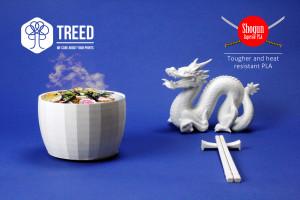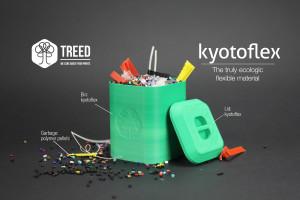Filament manufacturer TreeDFilaments has made a name for itself for proposing a wide range of exotic filaments to the market, from mineral based to high strength technical materials. For its latest products the company has turned to the Far East for inspiration by launching the new Shogun Superior PLA and kyotoflex ecologic flexible materials.
The Shogun Superior PLA is a new tougher blend of PLA which offers increased temperature resistance, being able to withstand temperatures of up to 90°C without suffering any deformation. Compared to TreedFilament standard Ecogenius PLA, it is up to 20% more resistant and is thus indicated low end mechanical applications.
This is done without compromising the material’s eco-compatibility. The Shogun Superior PLA is graded as fully biodegradable according to the EN13432 European ruling regulating biodegradability and compostability of polymer materials. No compromise has been made in terms of printability as well, since no heated plate or closed build chamber is required to avoid warping.
3D Printing with the Environment in Mind
The second new material also takes a popular trait in filament, flexibility, and improves it in terms of eco-sustainability. Its name inspired by the beautiful ancient imperial Japanese capital, kyotoflex is the first flexible filament that is also fully biodegradable. Available only in a matte green, to better convey its “green” factor, it is also easier to print than most flexible materials, even — according to TreeD — with bowden extruders. Recommended nozzle temperature is around 200°C and plate temperature should be set at a maximum of 40°C.
Kyotoflex was developed to ensure a good elongation at break, coming out with a 47 shore/D flexibility (similar to certain TPE polymers). It also offers a low hygroscopy level meaning it can be stored for longer periods without losing its mechanical properties. Ancient Japanese traditions can be an inspiration for many positive elements, from willpower strength to harmony with nature. All aspects that work just fine in a 3D printing filament.
Subscribe to Our Email Newsletter
Stay up-to-date on all the latest news from the 3D printing industry and receive information and offers from third party vendors.
Print Services
Upload your 3D Models and get them printed quickly and efficiently.
You May Also Like
Nikon SLM Solutions Sells SLM 500 to Primary Weapon Systems to Expand Suppressor Production
Primary Weapons Systems (PWS) is a Boise, Idaho-based manufacturer of suppressors, firearms, and related components. A subsidiary of Vigilant Gear and a sister company to aftermarket Glock slide manufacturer Lone...
3DPOD 261: Tooling and Cooling for AM with Jason Murphy, NXC MFG
Jason Murphy´s NXC MFG (Next Chapter Manufacturing) is not a generalist service; instead, the company specializes in making tooling. Using LPBF and binder jet, the company produces some of the...
HP and Firestorm Labs Form Partnership to Use Multi Jet Fusion 3D Printers in Deployable Factories
HP Inc., maker of a range of additive manufacturing (AM) solutions including the Multi Jet Fusion (MJF) ecosystem, has announced a partnership with Firestorm Labs, a developer of containerized, deployable...
3D Printing News Briefs, July 2, 2025: Copper Alloys, Defense Manufacturing, & More
We’re starting off with metals in today’s 3D Printing News Briefs, as Farsoon has unveiled a large-scale AM solution for copper alloys, and Meltio used its wire-laser metal solution to...


































